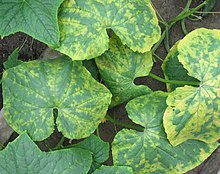Cucumber mosaic virus
| Cucumber mosaic virus | ||||||||||||||||||
|---|---|---|---|---|---|---|---|---|---|---|---|---|---|---|---|---|---|---|
| Systematics | ||||||||||||||||||
|
||||||||||||||||||
| Taxonomic characteristics | ||||||||||||||||||
|
||||||||||||||||||
| Scientific name | ||||||||||||||||||
| Cucumber mosaic virus | ||||||||||||||||||
| Short name | ||||||||||||||||||
| CMV / CuMV | ||||||||||||||||||
| Left | ||||||||||||||||||
|
The cucumber mosaic virus ( English Cucumber mosaic virus , CMV or CuMV ) is a very common plant virus in gardening. It attacks cucumbers ( Cucumis ) and pumpkins ( Cucurbita ), but also many other plants and is probably distributed worldwide. The isolates of the cucumber mosaic virus can be assigned to two different serotypes , which also have different biological properties.
morphology
The non-enveloped virus particles (virions) of the cucumber mosaic virus are round in shape and about 29 nm in diameter. They consist of a capsid made up of 180 capsomeres ( T = 3 ). These form hexons on each of the twenty sides of the icosahedron and pentons on the twelve corners ; this structure of 32 superordinate units, behind which an icosahedral symmetry is hidden, is called a quasi-icosahedron. The stability of the capsid for all members of the genus Cucumovirus is very dependent on the interaction with the packaged RNA molecules, since the interaction of the capsomeres with one another is only very weak. The capsids of the cucumber mosaic virus disintegrate in the presence of detergents or high salt concentrations that are able to dissolve the protein-RNA interaction. Most strains of the cucumber mosaic virus are unstable in the presence of Mg 2+ ions. All isolates can be inactivated at 60 ° C.
Genome
The genome of the cucumber mosaic virus consists of three single-stranded RNA molecules with positive polarity (RNA 1-3) and a tRNA -like, subgenomic RNA that is a copy of the second open reading frame of RNA-3. The RNA strands 1-3 each have a 5 'cap structure, but are not polyadenylated at their 5' end . The total size of the genome is about 8,000 nt , which is distributed over the RNA segments (RNA-1: 3,357 nt, RNA-2: 3,050 nt, RNA-3: 2,216 nt).
Biological properties
Species from 85 different plant families have been described as hosts of the cucumber mosaic virus , and over 1000 plant species have been infected experimentally. The virus overwinters mainly on perennial grasses, which are attractive to aphids (aphidoidea) in spring. The virus is then transmitted through the aphids. Another method of transmission is via the cutting tools used in horticultural maintenance. The virus is seed transmissible .
It causes mosaic appearances, compressions and leaf deformations on infected plants. The younger leaves can be blotchy to yellowish in color. The fruits are deformed and piebald.
In the marketing standard for cucumbers ( Regulation (EEC) No. 1677/88 ) it is stipulated that cucumbers infected with mosaics are to be excluded from marketing as "not healthy" due to their possible further spread. In animals and humans, the virus can neither trigger an infection nor cause disease.
application
Modified (immunologically optimized) capsid shells of CuMV ( Cucumber mosaic virus-derived VLPs , CuMVtt) are an approach to peanut allergy via vaccination to help.
swell
- Roossinck, M.J. et al. : Family Bromoviridae . In: C. M. Fauquet, M. A. Mayo et al. : Eighth Report of the International Committee on Taxonomy of Viruses . London, San Diego 2005, pp. 1049-1058 ISBN 0-12-249951-4
- Kenneth S. Smith: A Textbook of Plant Virus Diseases . 3rd edition London 1972 ISBN 0-582-46624-5
Individual evidence
- ↑ ICTV Master Species List 2018b v1 MSL # 34, Feb. 2019
- ↑ a b c d ICTV: ICTV Master Species List 2019.v1 , New MSL including all taxa updates since the 2018b release, March 2020 (MSL # 35)
- ↑ Ding SW, Anderson BJ, Haase HR, Symons RH: New overlapping gene encoded by the cucumber mosaic virus genome . In: Virology . tape 198 , no. 2 , February 1994, p. 593-601 , PMID 8291242 .
- ↑ T. A. Zitter, M. T. Banik: Virus Diseases of Cucurbits. October 1984, accessed March 3, 2008 .
- ↑ Luitgardis Seigner: Virus diseases in cucurbits. (No longer available online.) State Institute for Plant Protection Bavaria, archived from the original on March 21, 2008 ; Retrieved March 3, 2008 . Info: The archive link was inserted automatically and has not yet been checked. Please check the original and archive link according to the instructions and then remove this notice.
- ↑ Geisenheim: Marketing standard for cucumbers (Regulation (EEC) No. 1677/88). (No longer available online.) Federal Agency for Agriculture and Food, formerly the original ; Retrieved March 3, 2008 . ( Page no longer available , search in web archives ) Info: The link was automatically marked as defective. Please check the link according to the instructions and then remove this notice.
- ↑ Martin F. Bachmann, Federico Storni et al : Vaccine against peanut allergy based on engineered virus-like particles displaying single major peanut allergens , in: Journal of Allergy and Clinical Immunology, Volume 145, No. 4, April 2020, p. 1240 -1253.e3, doi: org / 10.1016 / j.jaci.2019.12.007 , abstract , PDF
- ↑ Harald Lesch: Kuhstallpille & Co - The allergy code cracked? , §How can allergies be stopped ?, broadcast by ZDF on May 26, 2020
